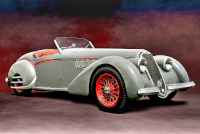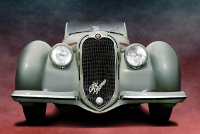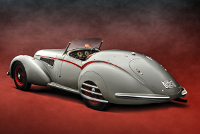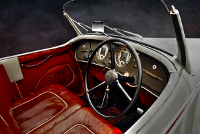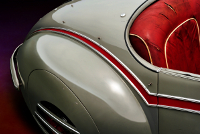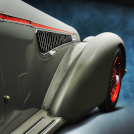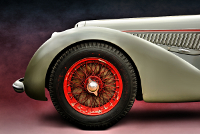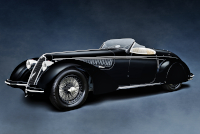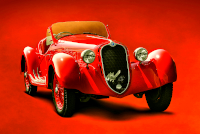Location:
Elegance at Hershey, 2013
Owner: Robert & Sandra Bahre | Oxford, Maine
Prologue:
The 8C 2900B Corto more closely follows the template of the 2900A, its wheelbase longer by a scant 50 mm. The proportions are comparable, the form a bit burly. Touring move toward an integrated alla spessa design ethic (perhaps best exemplified by the Lungo Touring Berlinetta), yet on the Corto Spider they maintain some of the delicate cues seen on earlier roadsters— cut-down doors, for instance, and a French sweep along the flank.
In this sense, the Corto 8C 2900B is an incremental step along Touring's design evolution, neither the ultimate expression of luxury, as in the 2900B Lungo, nor the ultimate competition car, as in the 2900B Mille Miglia. Of an already rare set, there are fewer passo corto 8C 2900B cars than passo lungo versions.
In the Alfa Romeo Two-Nine piece that Peter Hull and Simon Moore wrote for Automobile Quarterly, this Corto Touring Spider appears at the top of page 179. And as the car has not been restored, chassis #412018 looks today just about the same as it did then, even in monochrome. The perspective here in the main quarter shot is also rather similar, shown from a similar level. In any case, I like the continuity in publication so many decades apart. So those with a stack of AQs from the 1970s handy may compare.
- - - - - - - - - -
► Image Source 1, 2, 6, 8: Nikon D700 (12.1 MP) | Image Source 3, 4, 5, 7 by E, Nikon D200 (10.2 MP), illustrated by the author
References:
- Automobile Quarterly, Volume 11, Number 2, Second Quarter 1973, "The Immortal Alfa Romeo Two-Nine" by Peter Hull and Simon Moore, The Kutztown Publishing Company, Inc., Kutztown, PA, page 179, 181
- Moore, Simon. "The Immortal 2.9: Alfa Romeo 8C2900, Revised Edition" Parkside Publications, Inc., Seattle, WA. 2008, pages 149, 162-170, 462, and others
- Hemmings Motor News: "Unrestored 1938 Alfa Romeo 8C Wins Top Honors at Elegance at Hershey" by Kurt Ernst, June 20, 2013
- JalopyJournal.com: "The Story of Tommy Lee" by Ron Kellogg, January 13, 2010
- Chromoclassico.com: "Alfa 8C 2900B" A once-wonderful survey, but chassis #412018 was referenced as a long wheelbase car.
- Supercars.net: "1937-1938 Alfa Romeo 8C 2900B Corto Spider" by Richard Michael Owen
- Ultimatecarpage.com: "1937-1938 Alfa Romeo 8C 2900B Corto Touring Spider" by Wouter Melissen, March 26, 2010.
Desirable automobiles of great historical merit are seldom spared a cost-no-object restoration. This Alfa Romeo—for all intents and purposes the apogee of pre-War grand touring cars—has done just that. Chassis #412018 was last painted in 1950, and still wears the scrapes and scars from many a hard drive.
Please pardon the tenor of this story. This 8C's survival in original condition is a byproduct of a rather quiet life. The car has largely stayed in the United States and brings with it neither famous names nor great achievements. A brush with Tommy Lee lends some spark, but his are anecdotal exploits, and not entirely verified.
8C 2900B Chassis #412018 through 1952
Delivered to a customer in Switzerland, we know little about #412018's history before the war. One known photo from Switzerland shows the car with a uniform medium hue, wire wheels to match, a large hard-cast plate on the leading edge of the rear quarters, and no rear wheel skirts.
By the mid-1940s, #412018 travels to California where the young business magnate Tommy Lee takes ownership. Known for his stable of European racing machinery, Lee's enthusiasm turns his new acquisition into something of a local hot rod. At one point, he swaps in the motor from his Alfa Romeo Tipo B Grand Prix car, but the 8.5:1 compression requires an alcohol mix to run properly, and so the plugs foul after a scant 50 miles due to the lead content of pump petrol. Lee replace the Tipo B motor with the original.
AQ also suggest that this Alfa Romeo takes part in the first road race held at Watkins Glen, driven by Lee's mechanic, Mal Ord. This event is the first American road race held after World War II. However, after winding through that story in some detail while profiling George Weaver's Maserati V8RI, which led the first lap, the only similar Alfa reference I have seen is that of the 8C 2900B Berlinetta of Frank Griswold, who won the race. So I do not know if the Watkins Glen claim is true, or a mix-up among 2.9 cars. I would need to look more closely at the race itself as opposed to its select entrants.
In any case, chassis #412018 receives cosmetic changes over its succession of American owners. At the very least, the following changes do not match the Switzerland photo: The car receives Modernist rear wheel skirts with open slats and chrome strakes. The color changes from its medium hue (originally grey or blue-grey) to what in 2006 Paul Russel describes as "yellow ivory" when inspecting patches under the current grey coat. While in Lee's possession, or possibly a year of so later in the possession of Dr. Sam Scher, this color may have ivory. The car also receives a contrast color through the French sweep with wires painted to match, which Dr. Scher confirms is red.
Scher also provides one of those categorically devotional quotes about the 2.9: "The performance of the car is the most phenomenal that I have ever experienced and that is quite a statement for me to make since I have owned at least 50 sports cars."
In 1950, the car passes from Scher to Al Garthwaite of Philadelphia, traded for a Bugatti Type 57C and $1,000. At this point an interesting footnote appears, as on a few occasions Garthwaite sends the car to the Derham Body Co. of Rosemont, Pennsylvania for fresh updates including paint, mouldings, windwings, and exhaust silencers. Though of the piecemeal variety, this work is a rare reference to an coachwork activity at a time when few American coachbuilders yet survive. This latest change of paint, is also the most recent change of color. So the car remains grey with red trim.
Moore also notes that this car appears in the September 1951 issue of the Saturday Evening Post, with Werner Maeder driving past Central Park in New York. Maeder is at the time a well known mechanic of Zumbach's Garage, and in this case may have been involved in the car's technical well-being. Garthwaite keeps the car until August 16, 1952, passing #412018 to the Iselin family, who keep the car for over 20 years.
Bill Serri and the 8C 2900
At this stage, a pause, because the history of #412018 is mainly a chain of ownership through the 20th century; it is more about who knows whom and who wants to collect which car than anything resolutely historical. The remarkable thing, however, is that no one restores the car. The interior is original, the mechanical components are original, and the paint remains as-is since Derham's last update in 1950.
Bill Serri, who owns the car in the 1980s, comments, "When contemplating 412018, the icing on the cake is the car's superb original condition. The original red leather upholstery and interior are in beautiful condition. The original rubber pedal pads are stored in the glove box. The original colour—a greyish blue—was painted over in grey sometime in the early 1950s. The condition of the paint is not bad, but when it needs refinishing I am presently leaning toward burgundy with cream on the stripe and the wheels."
Mr. Serri does not repaint the car before passing it to Bob and Sandra Bahre, they of New Hampshire Motor Speedway notoriety. And so the car remains today.
Up until 2024, when the unrestored 1934 Bugatti Type 59 wins best of show at Pebble Beach, perhaps no preservation car receives the same respect other than this Alfa Romeo, which wins the 2013 Elegance at Hershey.
As a parting note, I will return to Mr. Serri's words, if merely to further the theme of devotion for the 2.9: "In early 1979, the Iselin car finally changed hands, and sooner thereafter I finally managed to acquire it and brought it home. I have been madly in love with it ever since, for it never tires my eyes. I can walk around the car for hours enjoying each view more than the last. Upon viewing the car, a lady friend of mine was taken with the urge to pinch it—a bit drastic, but I certainly identified with the feeling. The Italians have always imbued the quality of emotion in their cars and the Alfa affects me more this way than any Bugatti.
On the road all these feelings coalesce. The performance and handling are astonishing—even by modern standards. The hydraulic brakes are entirely adequate for a car of this size and power. The sound is pure music as the revs rise and fall with each shift of the thoroughly satisfying gearbox. When you put your foot down hard, you can just feel the power, and believe me, everyone knows you are coming for this is no quiet car.
When I'm just tooling along, I seem to be passing everyone in sight. The only place to really get on it is a road where I'm all by myself. As I become better acquainted with the car, the curves become ever more pleasurable—even inviting abandon as the steering is feather light and the chassis superbly balanced. The only negative factor is the rather prodigious use of fuel—around 10 miles per US gallon—but this could be improved greatly with a more conservative foot."
So ends another grand impression of the 2.9, which, even as a de-tuned car of modest specification compared to its racing brethren, provides enough tractable road performance to humble much newer machines. If only Mr. Serri had seen the completion of #412031, the 1938 Mille Miglia winner, because he owned that car, too. But the MM Touring Spider will pass to Dr. Fred Simeone during its Phil Hill restoration sometime around 1984. Just prior, Mr. Serri briefly tests #412031 as a rolling chassis, only to discover a defect in the crankcase caused by accidental lead spill.
So #412018 would seem downright practical. "This is the first collector car I have really coveted which I could just fire up and enjoy as it has needed very little mechanical attention." In other words, the 2.9 is not merely great and immortal and all such other superlatives, it is a good car.
Motor: 2,905 cc straight 8-cylinder, alloy block, fixed aluminum hemi-head | 68 mm x 100 mm | 5.75:1 compression
Valvetrain: DOHC, 2 valves per cylinder, gear-driven via a central mechanism between each 4-cylinder block
Aspiration: twin Weber BS42 carburetors with twin Roots-type superchargers, each feeding one 4-cylinder block
Power: 180 bhp at 5,200 rpm
Compared to the race-bred 2900A, the road-going B uses a tame 5.75:1 compression ratio, down from the sports-racer's 6.5:1.
Drivetrain: 4-speed gearbox in transaxle rear-wheel drive layout
Front Suspension: independent double-wishbone with coil springs over dampers
Rear Suspension: independent swing axle on transverse semi-elliptic leaf springs with radius arms for location and both hydraulic and friction dampers
Architecture: steel ladder-frame chassis with Superleggera coachwork by Touring of Milan, a steel central body section with aluminum fenders, valance, bonnet, and cowl; the build number is 2016
Kerb Weight: 1,278 kg (2,817.5 lbs)
A point of minutiae, Moore cites the weight at the time of the car's import to Switzerland on February 18, 1938.
Wheelbase: 2,800 mm (110.2 inches)
0-60: about 9.4 seconds
Top Speed: 180 km/h (about 112 mph)
Alfa Romeo provided an estimate of 115 mph at the time of motoring journalist reviews, notably The Autocar's test at Brooklands in 1937, which yielded 111.8 mph. The same test yielded the 0-60 time printed above.
Etymology:
'8C 2900' refers to the motor, an 8-cylinder of 2.9 litre displacement. The 'B' designation refers to the second version of the 2900's development program, which began in 1935 with the 2900A. 'Corto' indicates this example is one of the rarer short wheelbase versions, or passo corto, of the 8C 2900. 'Touring Spider' indicates the coachbuilder Touring of Milan built this sporting, open two-seater body.
Figures:
Simon Moore lists 51 recognized 8C 2900 chassis plus one additional motor. On these chassis, Touring provide three roadgoing configurations that define the classic 8C 2900B. These versions are the short chassis spider (corto), the long chassis spider (lungo), and the long chassis berlinetta, which total 18 original cars.
Touring produce six corto spiders on early chassis numbers: #412011, which is the prototype, later rebodied in Germany by Nowack, #412014, #412016, #412017, #412018, and #412019.
The first berlinetta for the Paris Salon follows in October of 1937 (#412020). Then the remainder of production alternates between lungo spiders and berlinettas.
French Dip: French Styling in the Short Chassis 8C 2900B
Corto and lungo variants differ primarily in the shoulders, which on the short chassis cut down aft of the cockpit. The doors slant on a gentle angle, accentuated by a French sweep in chrome and contrasting paint, which hits a sharp checkpoint just before the rear arches. In comparison, the lungo is more linear, with a set of trailing chrome pieces that break farther apart and terminate at different points, the lower piece ending against the rear arch while the upper piece extends all the way down at the tail.
This difference in chrome accents lends distinct character to each of the short and long-chassis Touring Spiders, though the difference is not absolute. Corto chassis #412016, for instance, uses the lungo style, and at least one lungo chassis appears to use the corto style.
Another difference Moore points out, the headlamp sit slightly forward on this car. Consequently, the pods are a bit larger and longer; they are also color-matched to the body, which echoes the French theme with a style that is absent on all other Touring Spiders.
Teardrop Vents: Slatted Wheel Skirts on the 8C 2900B
Best viewed from the tail perspective, each of the rear skirts bears a slatted, removable cover for accessing the wheels. The teardrop shape of the opening is beautifully fashioned, though the chrome that accents each slat detracts somewhat from this otherwise modest, and peculiarly saddened eyelet. This three-slat skirt pattern appears more prevalent on the short-chassis version of the 8C 2900B Touring Spider, though some of the corto examples use plain covers instead.
These skirt covers may also be a later addition, as they do not appear in the oldest known photograph of #412018. The rear chrome plating is also a likely change from the original. Instead of sharp chrome, the car previously wore a large hard rubber guard on the front edge of the rear quarters. This configuration, particularly without rear skirt covers, would make #412018 very similar to #412016. The exception (as noted above) is that #412016 is one of those rare passo corto Touring Spiders that uses the lungo style flank—no cut down doors, no French sweep, but a straight body and diverging chrome strakes.
Chassis #412017, which no longer exists, was also very similar to #412018. That car uses the French sweep passo corto style seen here on #412018, with what may be original rear wheel covers in the Modernsit teardrop style. However, these inserts used a single opening without slats, and there was no chrome on the covers or the body.
Smooth Tail: The Sole 8C 2900B with Integrated Tail Lights
Of all known 8C 2900B Touring Spiders, whether corto or lungo chassis, #412018 is the only one whose tail lights are integrated into the coachwork. Most 8C 2900B examples use a separate tri-light attachment above the license plate. This car takes similarly sized lenses and creates an improvised marker light arrangement mid-way down the boot lid, which does appear to be an original design feature.
The tail treatment is smart, and in many ways pairs nicely with the car's unique headlamps. Though fussier than the typical Touring Spider, in part owing to its fancy wheel skirts, #412018 is perhaps the most French, even if accidentally.
Last Updated: Apr 19, 2025

